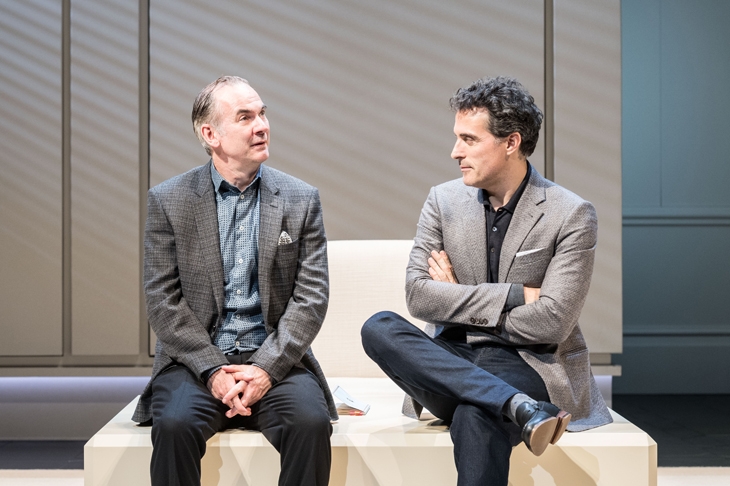God, what a dusty old chatterbox Schiller is. Like Bernard Shaw, he can’t put a character on stage without churning out endless screeds of cerebral rhetoric. But unlike Shaw, he has no sense of humour, nor any instinct for the quirks and grace notes that create a personality. Mary Stuart is a psychological drama with a single issue. How soon, and with what political consequences, can Elizabeth execute her treacherous cousin Mary? Schiller’s characters sound and feel identical: super-brainy, highly confident know-alls who treat each problem like a gang of Chancery briefs discussing a particularly knotty insolvency case.
Director Robert Icke’s regimented production imposes high-street fashions on England in the 1560s. The courtiers wear sharky two-piece suits like Apprentice candidates. Elizabeth sports a black velvet jacket, as if she were Melvyn Bragg taking a stroll on Hampstead Heath. Mary favours trousers too, naturally enough, and a secretarial blouse with pointy collars. Nothing conjures up Tudor England like the M&S daywear range. Schiller’s convoluted jabber grinds on for an hour before a vague sub-plot surfaces.
Two of Mary’s spies, posing as Elizabeth’s supporters, vow to advance the Catholic cause, but their scheme pegs out after a foreseeable act of treachery. At curtain-up, the audience is treated to a novelty. A coin is spun to determine which actress will play which queen. But Icke has chosen players from the wrong age group. I saw Lia Williams, in her middle years, playing Mary (aged 24 at the time), and Juliet Stevenson, a few Christmases short of a free bus pass, playing the 33-year-old Elizabeth.
In one sense this barely matters because Schiller is incapable of treating his women as women. English folklore has amusing tales of Elizabeth’s jealous fascination with Mary’s looks, stature and complexion but the lumbering German gas bag can’t find space for such feminine touches. The pivotal scene, the famous encounter between the two rivals invented by Schiller, proves a disappointment. Neither character has a credible dramatic goal. Mary affects to beg Elizabeth for her freedom but any fool can see that this request will fail. And Elizabeth has no conceivable reason to meet her enemy. The scene turns into a weird game of one-upmanship between two haughty smart Alecs. Shifty Mary goads and taunts the icy Elizabeth until the stalemate is broken when they lunge at each other, panting and clawing, in a burst of regal cage-fighting. Scurrying courtiers pull them apart and Elizabeth is hustled off-stage. A messenger then reports that she’s been assassinated. This cliffhanger ends the first act. But what a useless cliffhanger. Everyone knows the report is false.
Equally untrue is Schiller’s representation of Elizabeth as a prissy whiner who likes to bore her court with the observation that monarchy equals captivity. The real Elizabeth was a plucky and resourceful operator whom some regard as the most able and intelligent occupant of the English throne. I’d give this three-hour bum-number a wide berth. And yet the story itself has oodles of dramatic potential and deserves to be reworked by a young female playwright with an eye for a gag and a feeling for girl-on-girl rivalry.
Theatre’s holy grail is the play for people who dislike theatre. Art by Yasmina Reza is a contender for the title. It’s dead simple. Serge buys a conceptualist painting, all white with faint diagonal hatchings, which his friend Marc dismisses as a pretentious dud. A mutual pal, Yvan, is called in to umpire the dispute but his equivocations cause the friends to fall out.
Matthew Warchus’s beautiful production is stark, restrained and wonderfully stylish. Sex god Rufus Sewell (Serge) reveals himself as a comedian of sly and sinuous abilities. Even the play’s flaws work in its favour. The banter between the male chums doesn’t quite ring true because real men tend to use taunts based on bedroom inadequacies, on genital shortcomings, on latent homosexuality, on closet paedophilia, that kind of thing. These men are too sophisticated for that. Their readiness to insult each other’s wives feels wrong as well. But it makes no difference because the characters aren’t males at all so much as human abstractions. Any cosy clique facing an unexpected upheaval would implode in the same way. They might be a school gang bickering at a bus stop, or business pals learning to accommodate a new partner, or a world-famous band discomfited by the lead singer’s incoming girlfriend. One thinks of Yoko and the Beatles. This is the play’s strength and its universality. The final scenes include a pair of superb visual gags and a shocking emotional reversal that reinforces one’s belief in humanity and the power of friendship.
Every positive word said about this amazing play is richly deserved. A wonderful show. And brief too. About 85 minutes. Hence its claim to be the holy grail.







Comments